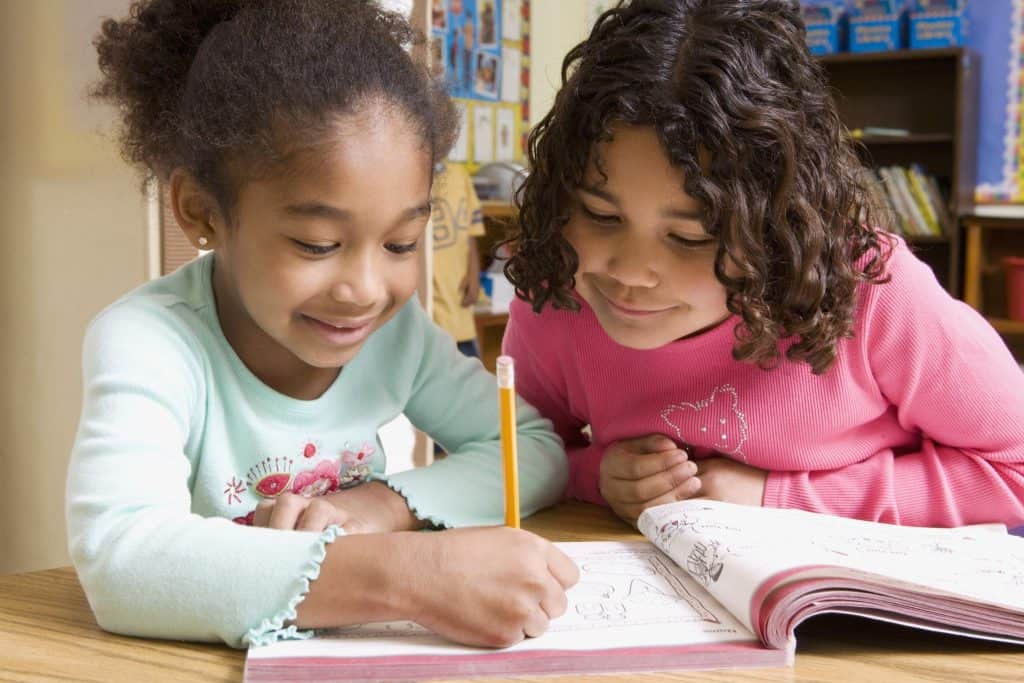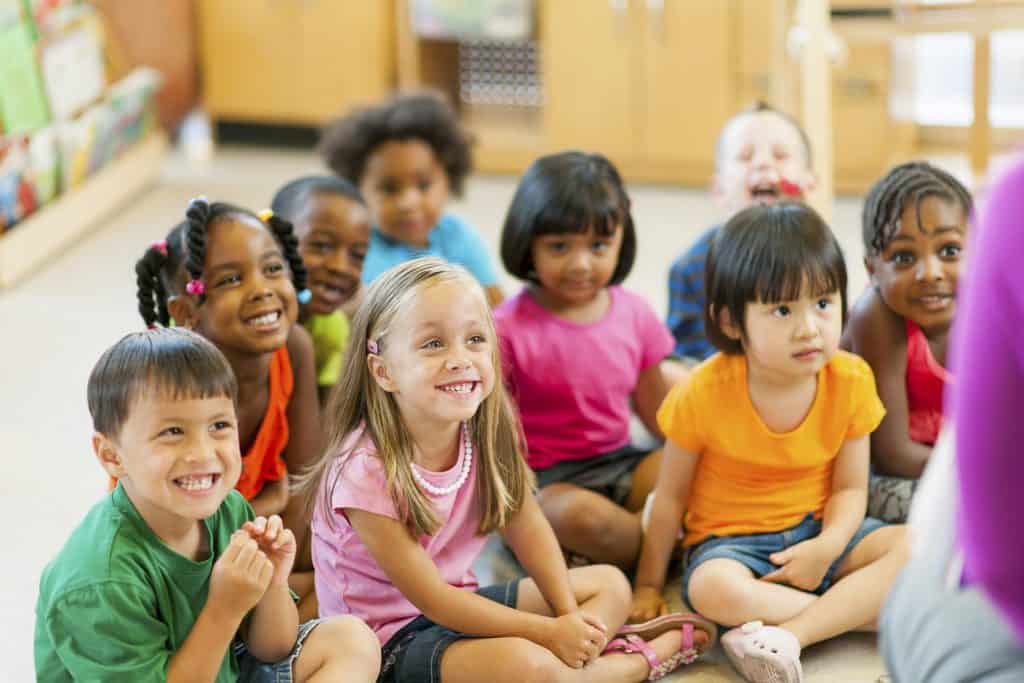When you think of what makes a child thrive at school, you might think of intelligence or physical health. But social-emotional learning (SEL) is just as important for students to develop. Children with strong SEL skills don’t only achieve higher test scores. They also make positive relationships with others, and they are less likely to develop psychological or behavioral problems. Even the brightest or most physically fit students cannot reach their potential without SEL skills.
As educators, our focus should be on more than teaching students how to pass standardized tests. Nurturing a child’s social-emotional health is just as, if not more, essential for student achievement. Want to revolutionize your classroom environment and prepare your students for a lifetime of success? Learn what social-emotional development is and how to teach SEL skills in your classroom.
What is Social-Emotional Development?
 To effectively teach SEL curriculum, you must familiarize yourself with social-emotional development. This refers to a child’s ability to regulate emotions and interact with the world around them. Social-emotional development occurs alongside cognitive and physical development and is just as crucial for well-being. In fact, the pathways our brains make to process emotions during early childhood development are the same that we use for mental cognition.[1] These processes all work together to help students reach their potential. If one is underdeveloped, the others suffer as a result.
To effectively teach SEL curriculum, you must familiarize yourself with social-emotional development. This refers to a child’s ability to regulate emotions and interact with the world around them. Social-emotional development occurs alongside cognitive and physical development and is just as crucial for well-being. In fact, the pathways our brains make to process emotions during early childhood development are the same that we use for mental cognition.[1] These processes all work together to help students reach their potential. If one is underdeveloped, the others suffer as a result.
Although children pick up some interpersonal relationship skills through observation, they benefit greatly from a little help. From infancy to toddlerhood and beyond, children develop SEL skills best when they have direct instruction and feedback. Parents or guardians are the most important influencers, but teachers can also strengthen a child’s social abilities. Since school is the place children spend the most time outside of their house, teachers share a special responsibility to nurture social-emotional development.
While social skills develop all throughout life, they grow most rapidly between the ages of zero and five. This is when babies and young children are just learning how to interact with their environment. Any habits they pick up during these ages are likely to influence them throughout childhood and possibly adulthood, too. For this reason, the earlier students receive a strong SEL education, the better.
The CASEL Five Core Competencies
The Collaboration for Academic, Social, and Emotional Learning (CASEL) is a leading research organization for social-emotional development. Its primary mission is teaching social-emotional skills to students from PreK to high school to benefit them and their communities. Researchers at CASEL have developed an instructional framework for SEL curriculum called the “CASEL Five Core Competencies.”[3]
These five CASEL competencies are:
- Self-awareness: the ability to recognize your emotions, see yourself from another person’s perspective, and discover your strengths and weaknesses
- Relationship skills: the ability to create and maintain healthy relationships with a variety of people
- Responsible decision-making: the ability to make choices about your behavior based on ethics, safety, and social norms
- Self-management: the ability to regulate your feelings to manage stress, develop positive goal-setting strategies, and control your impulses
- Social awareness: the ability to consider another person’s perspective, have empathy, and appreciate diversity
Multiple studies have confirmed that the CASEL competencies are essential for success and that teaching them to students can improve their overall well-being.[1] Use them as an SEL assessment of sorts to make sure your school’s program is focusing on the right skills.
How SEL Can Improve Your School Climate
Students who receive social-emotional training in schools are more likely to:
- Achieve high grades and test scores[4]
- Have high self-esteem[5]
- Develop resilience and positive coping mechanisms[6]
- Graduate from high school[4]
- View teachers and classmates positively[3]
They are also less likely to:
- Experience high stress levels[8]
- Earn classroom rule infractions[3]
- Develop depression or anxiety disorders[5]
- Become chronically absent[6]
- Require discipline or redirection in class[7]
SEL programs promote academic success and can even help close achievement gaps for struggling students. But the benefits of strong social-emotional development reach far past the classroom. Social-emotional skills help students develop fulfilling relationships, deal with setbacks or obstacles in life, and even prepare for their future careers. The best thing educators can do to raise their graduation rate, reduce chronic absenteeism, and encourage collaboration in the classroom is include SEL curriculum.
Parents and teachers benefit when their students receive SEL education, too. When educators teach students SEL skills, they tend to feel more positively about their jobs and collaborate more with their colleagues.[12] And schools that adopt SEL programs notice significantly higher parent engagement rates.[13] Every member of the school community flourishes when students have the right tools to overcome challenges and make positive relationships.
Beyond the school level, SEL programs are an economic investment. Research suggests that teaching students SEL skills can provide an $11 return for every $1 spent.[14] And because automation has done away with many repetitive and solitary jobs, interpersonal skills are essential for the workplace.[15] Teaching students SEL skills prepares them for a successful career and to contribute to their society.
How to Teach Social-Emotional Learning at School
Social-emotional learning can significantly improve your school’s environment and help students develop healthy social skills. You as an educator can utilize time spend with your students to sharpen SEL abilities alongside academic ones.
A meta-analysis of 213 social-emotional school programs showed that CASEL-based SEL training is most effective when it involves the following four SAFE practices:[16]
- Sequenced: Connected, coordinated activities
- Active: Dynamic and varied activities that engage students
- Focused: Has at least one component devoted to developing SEL skills
- Explicit: Targets specific CASEL skills rather than SEL as a whole
Suppose, for example, that you want to teach your first-grade class social skills. Instead of encouraging students to “use their manners,” you could read picture books about compassion (Sequenced) with discussion questions (Active) to teach your students about social awareness (Focused, Explicit). Teaching any social skills is better than no instruction, but SAFE strategy helps focus your methods.
By integrating the SAFE strategy into your school’s SEL programs, you can model it in a way that primes it for success. Plus, you can always adapt the SAFE strategy to fit your classroom’s specific needs. If you want to teach several skills at once or include non-CASEL skills, for example, you can use the SAFE strategy as a guideline instead of a hard and fast rule.With the CASEL core competencies and SAFE strategy as your social-emotional resources, you’re sure to create a thoughtful program for your classroom.
Here are a few additional tips to make the most of your school’s SEL curriculum:
- Align social-emotional learning activities with your regular classroom instruction. You could, for example, read a book about willpower to teach students self-management and literacy
- Teach your students mindfulness meditation, which is shown to improve several CASEL competencies, especially for students with disabilities[17]
- Students develop social-emotional skills best in safe, caring classroom environments. Make cultural sensitivity a priority in SEL programs and school as a whole
- Model SEL behavior for your students to help them learn what you teach them in activities. You could, for example, celebrate cultural diversity to promote social awareness
- Involve parents in teaching children SEL skills. The most effective SEL programs are those that partner with families[17]
Sources:
Viadero, D. (2007, December 19). Social-Skills Programs Found to Yield Gains in Academic Subjects. Education Week, 27(16).[1]
Collaborative for Academic, Social, and Emotional Learning. Core SEL Competencies. Retrieved from casel.org: https://casel.org/core-competencies/.[2]
Aber, J. L., Jones, S. M. Brown, J. L. Chaudry, N. & Samples, F. (1998). Resolving Conflict Creatively: Evaluating the Developmental Effects of a School-Based Violence Prevention Program in the Neighborhood and Classroom Context. Development and Psychopathology, 10, pp. 187-213.[3]
Hong, S. (2011, March). The Impact of Enhancing Students’ Social and Emotional Learning: A Meta-Analysis of School-Based Universal Interventions. Child Development, 82 (1), pp. 405-32.[4]
Zins, J. (2016). Social and Emotional Learning. Retrieved from healthyselfesteem.org: http://healthyselfesteem.org/about-self-esteem/social-and-emotional-learning/.[5]
Coholic, D.H. (2011, January 07). Exploring the Feasibility and Benefits of Arts-Based Mindfulness-Based Practices with Young People in Need: Aiming to Improve Aspects of Self-Awareness and Resilience. Child & Youth Care Forum, 40(4), pp. 303-17.[6]
Payton, J., Weissberg, R.P., Durlak, J.A., Dymnicki, A.B., Taylor, R.D., Schellinger, K.B., & Pachan, M.(2011, January 07). The Positive Impact of Social and Emotional Learning for Kindergarten to Eighth-Grade Students: Findings from Three Scientific Reviews. Child & Youth Care Forum, 40(4), pp. 303-17.[7]
Collaborative for Academic, Social, and Emotional Learning. Austin Independent School District. Retrieved from casel.org: https://casel.org/partner-districts/austin-independent-school-district/.[8]
Schonert-Reichl, K. A., & Lawlor, M. S. (2010). The effects of a mindfulness-based education program on pre- and early adolescents’ well-being and social and emotional competence. Mindfulness, 1, pp. 137-151.[9]
Stukas, A. A., Clary, E.G., & Snyder, M. (1999). Service learning: Who benefits and why. Social Policy Report, Society for Research in Child Development, 8 (4), 1-22.[10]
Bell, M., and Wolfe, C. (2004) Emotion and Cognition: An Intricately Bound Developmental Process. Child Development, 75(2), pp. 366–70.[11]
Brock, L. L., Nishida, T. K., Chiong, C., Grimm, K. J., & Rimm-Kaufman, S. E. (2008). Children’s perceptions of the classroom environment and social and academic performance: A longitudinal analysis of the contribution of the Responsive Classroom Approach. Journal of School Psychology, 46, pp. 129-149.[12]
Elias, M. J., Leverett, L., Duffell, J.C., Humphrey, N., Stepne, C., & Ferrito, J. (2016, March 24). How to Implement Social and Emotional Learning at Your School. Retrieved from edutopia.org: https://www.edutopia.org/blog/implement-sel-at-your-school-elias-leverett-duffell-humphrey-stepney-ferrito.[13]
Belfield, C., Bowden, B., Klapp, A., Levin, H., Shand, R., & Zander, S. (2015). The Economic Value of Social and Emotional Learning. Center for Benefit-Cost Studies in Education.[14]
Deming, D. J. (2015). The Growing Importance of Social Skills in the Labor Market. The Quarterly Journal of Economics, 132(4), pp. 1593-1640.[15]
O’Connor, R., Feytor, J.D., Carr, A., Luo, J.L., & Romm, H.(2017, February). A review of the literature on social and emotional learning for students ages 3–8: Characteristics of effective social and emotional learning programs. ICF International.[16]
Elias, M.J. (2003). Educational Practices Series: Academic and Social-Emotional Learning. International Bureau of Education.[17]

